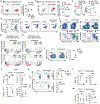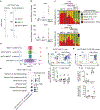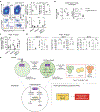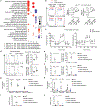PTEN directs developmental and metabolic signaling for innate-like T cell fate and tissue homeostasis
- PMID: 36302969
- PMCID: PMC10080469
- DOI: 10.1038/s41556-022-01011-w
PTEN directs developmental and metabolic signaling for innate-like T cell fate and tissue homeostasis
Abstract
Phosphatase and tensin homologue (PTEN) is frequently mutated in human cancer, but its roles in lymphopoiesis and tissue homeostasis remain poorly defined. Here we show that PTEN orchestrates a two-step developmental process linking antigen receptor and IL-23-Stat3 signalling to type-17 innate-like T cell generation. Loss of PTEN leads to pronounced accumulation of mature IL-17-producing innate-like T cells in the thymus. IL-23 is essential for their accumulation, and ablation of IL-23 or IL-17 signalling rectifies the reduced survival of female PTEN-haploinsufficient mice that model human patients with PTEN mutations. Single-cell transcriptome and network analyses revealed the dynamic regulation of PTEN, mTOR and metabolic activities that accompanied type-17 cell programming. Furthermore, deletion of mTORC1 or mTORC2 blocks PTEN loss-driven type-17 cell accumulation, and this is further shaped by the Foxo1 and Stat3 pathways. Collectively, our study establishes developmental and metabolic signalling networks underpinning type-17 cell fate decisions and their functional effects at coordinating PTEN-dependent tissue homeostasis.
© 2022. The Author(s), under exclusive licence to Springer Nature Limited.
Conflict of interest statement
Competing interests statement
H. Chi is a consultant for Kumquat Biosciences, Inc. P.G. Thomas is on the scientific advisory board of Immunoscape and Cytoagents, and has consulted for or received personal fees from Mirror Biologics, PACT Pharma, Johnson & Johnson, Pfizer, 10X Genomics, Illumina, and Elevate Bio, and has a sponsored research agreement with Elevate Bio. The remaining authors declare no competing interests.
Figures












Comment in
-
PTEN checkMAITs type-17 innate-like T cells.Nat Cell Biol. 2022 Nov;24(11):1565-1567. doi: 10.1038/s41556-022-01012-9. Nat Cell Biol. 2022. PMID: 36302968 No abstract available.
References
Methods-only references
Publication types
MeSH terms
Substances
Grants and funding
LinkOut - more resources
Full Text Sources
Molecular Biology Databases
Research Materials
Miscellaneous

